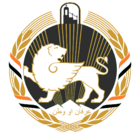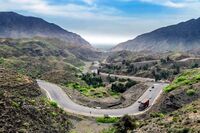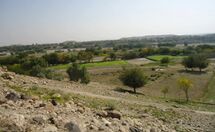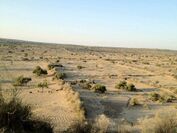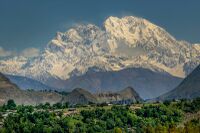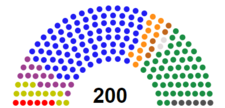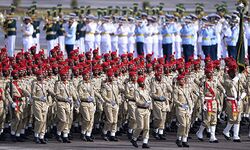Gulbistan: Difference between revisions
No edit summary |
No edit summary |
||
| Line 140: | Line 140: | ||
'''Gulbistan''' ({{wp|Pashto Language|Mershi}}: ګلبستان; Gulbistān ), officially the '''Federation Of Gulbistan''' ({{wp|Pashto Language|Mershi}}: د ګلبستان فدراسیون; Da Gulbistān Federāsion): is a {{wp|Federation|Federal}} {{wp|Presidential Republic|Presidential Republic}} located in northeast [[Satria]] on the continent of [[Coius]]. It is bordered by [[Rajyaghar]] to the west, [[Ajahadya]] to the south, and [[Zorasan]] to the east. | '''Gulbistan''' ({{wp|Pashto Language|Mershi}}: ګلبستان; Gulbistān ), officially the '''Federation Of Gulbistan''' ({{wp|Pashto Language|Mershi}}: د ګلبستان فدراسیون; Da Gulbistān Federāsion): is a {{wp|Federation|Federal}} {{wp|Presidential Republic|Presidential Republic}} located in northeast [[Satria]] on the continent of [[Coius]]. It is bordered by [[Rajyaghar]] to the west, [[Ajahadya]] to the south, and [[Zorasan]] to the east. | ||
Gulbistan was settled by humans over 60,000 years, but the first major settlement was the ancient city of [[Amtes]], today known as [[Hamtash]]. By the year 2500BC {{wp|Indo-European Language|Satro-Eucleans}} arrived in the region from the east, and dominated the region. | Gulbistan was settled by humans over 60,000 years, but the first major settlement was the ancient city of [[Amtes]], today known as [[Hamtash]]. By the year 2500BC {{wp|Indo-European Language|Satro-Eucleans}} arrived in the region from the east, and dominated the region. Amstia would be the largest of several small states that were built on being trade hubs between Satria, [[Rahelia]], and [[Euclea]]. Ancient Piraeans even settled and founded numerous settlements on Gulbistan's shores, the largest being the city of [[Thyropinia]], which eventually became its own state that would mix with Amstians and other ancient peoples until their fall. The ancient {{wp|Bactria|Amtsians}} would eventually be conquered by early Pardarian [[Heavenly Dominions]] and would Gulbistan would be turn into a land inhabited by the {{wp|Pashtuns|Mershi people}}. These Mershi would establish several medieval dynasties such as the [[Hunzad]] and [[Pafdari]] Empires. The region would also be settled by Togotis, Satrians, and Pardarians during this period and resulted in the rise of a multilinguistic and multicultural society arose.The Pardarians would reconquer Gulbstian under the Third Dominion, but after its collapse the Rahelian-Mershi Muhab clan would take control of the power vacuum left and formed the [[Muhabid Empire]], who would eventually be overthrown by a clan native to [[Khandaffi]] who formed the [[Khandaffid Empire]]. | ||
During the 16th century, the [[Khandaffid Empire]] was invaded by the [[Togoti Khaganate]]. The Togotis would rule the region until its split, when Gulbistan became part of the [[Khardarid Khanate]]. During there rule many Mershi clerics and scholars began the groundwork for Mershi nationalism, promoting a Mershi-based independence movement. This independence would eventually come in 1706 with the [[Zemani Uprising]] and the capture of the Dostak Fortress, this would establish the [[Zemani Empire]]. The Zemani Empire grew slowly at first, but would eventually form an unlikely relationship with [[Paretia]], who would supply the Zemani with Euclean weaponry and military advisors in turn for trading and commercial control as well as the selling of [[Thyropinia]] to Paretia. The Zemani would expand across Gulbistan and find itself in conflict with all of its neighbors. They would specifically target the [[Naratha Confederacy]] of modern-day Rajyaghar. A series of bloody wars between the two would weaken Gulbistan as well as the dwindling support from Paretia and the rise of Etrurian influence. The Zemani Empire would also establish [[Edgamic Law]], in which the non-Mershi peoples of Gulbistan were tobe assimilated into the dominant culture as well, it also promoted literacy and Irfan. Gulbistan would eventually fall to Etrurian colonial rule in 18XX and would be transformed into the Dominion Of Galbaterra. During Etrurian rule, the Mershi ruling class would continue to propogate Edgam with very little intervention. | |||
The | |||
During the [[Great War]], Gulbistan would be swept with ideas of independence, and so several independence groups arose and allied with the Ajahadyans during the war. During the Great War, the [[Spear Of Khoda]], [[Wolekhoda]], and [[Gulbi State Army]]. However, with Etruria winning the war, Gulbistan would remain Etrurian for another decade. During the [[Solarian War]], The SOK and GSA would lead rebellion with the support of many nations. The SOK would be given support by Euclea and in particular Paretia, and the GSA would become a [[Green Pardal]] movement during the war and the two groups would become enemies. This led to the [[Gulbistani War Of Independence]] following the war which would occur in conjunction with the [[First Satrian War]], in which the warring groups would lose tons of formerly Galbaterran land. The SOK would eventually come out on top and would establish | |||
==Etymology== | ==Etymology== | ||
==History== | ==History== | ||
Revision as of 23:26, 6 June 2021
This article is incomplete because it is pending further input from participants, or it is a work-in-progress by one author. Please comment on this article's talk page to share your input, comments and questions. Note: To contribute to this article, you may need to seek help from the author(s) of this page. |
Federation Of Gulbistan | |
|---|---|
| Motto: عرفان او وطن "Erfān aw Watan"
"Irfan and Homeland" | |
| Anthem: د روان ـنازوشان Da Ravān Zazošān" "Spirit Of Zaxosios" | |
Location of Gulbistan(dark blue) in Coius(light blue) | |
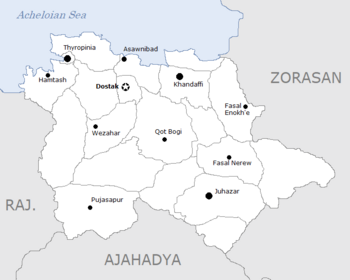 | |
| Capital | Dostak |
| Largest City | Thyropinia |
| Official languages | Mershi |
| Recognised regional languages | Abali and others |
| Demonym(s) | Gulbistani |
| Government | Federal Presidential Republic |
• President | Omar Sherzai |
| Legislature | Federal Congress |
| Tribal Jirga | |
| People's Jirga | |
| Establishment | |
• Independence | 1946 |
• Federation Established | 1995 |
| Population | |
• 2020 census | |
| GDP (PPP) | 2020 estimate |
• Total | |
• Per capita | $4,519.87 |
| GDP (nominal) | 2020 estimate |
• Total | |
• Per capita | $4,375.99 |
| Gini (2020) | 41.5 medium |
| HDI (2020) | 0.642 medium |
| Currency | Wazen (WZN (وزن)) |
| Date format | dd.mm.yyyy |
| Driving side | right |
| Calling code | +109 |
| Internet TLD | .pa |
Gulbistan (Mershi: ګلبستان; Gulbistān ), officially the Federation Of Gulbistan (Mershi: د ګلبستان فدراسیون; Da Gulbistān Federāsion): is a Federal Presidential Republic located in northeast Satria on the continent of Coius. It is bordered by Rajyaghar to the west, Ajahadya to the south, and Zorasan to the east.
Gulbistan was settled by humans over 60,000 years, but the first major settlement was the ancient city of Amtes, today known as Hamtash. By the year 2500BC Satro-Eucleans arrived in the region from the east, and dominated the region. Amstia would be the largest of several small states that were built on being trade hubs between Satria, Rahelia, and Euclea. Ancient Piraeans even settled and founded numerous settlements on Gulbistan's shores, the largest being the city of Thyropinia, which eventually became its own state that would mix with Amstians and other ancient peoples until their fall. The ancient Amtsians would eventually be conquered by early Pardarian Heavenly Dominions and would Gulbistan would be turn into a land inhabited by the Mershi people. These Mershi would establish several medieval dynasties such as the Hunzad and Pafdari Empires. The region would also be settled by Togotis, Satrians, and Pardarians during this period and resulted in the rise of a multilinguistic and multicultural society arose.The Pardarians would reconquer Gulbstian under the Third Dominion, but after its collapse the Rahelian-Mershi Muhab clan would take control of the power vacuum left and formed the Muhabid Empire, who would eventually be overthrown by a clan native to Khandaffi who formed the Khandaffid Empire.
During the 16th century, the Khandaffid Empire was invaded by the Togoti Khaganate. The Togotis would rule the region until its split, when Gulbistan became part of the Khardarid Khanate. During there rule many Mershi clerics and scholars began the groundwork for Mershi nationalism, promoting a Mershi-based independence movement. This independence would eventually come in 1706 with the Zemani Uprising and the capture of the Dostak Fortress, this would establish the Zemani Empire. The Zemani Empire grew slowly at first, but would eventually form an unlikely relationship with Paretia, who would supply the Zemani with Euclean weaponry and military advisors in turn for trading and commercial control as well as the selling of Thyropinia to Paretia. The Zemani would expand across Gulbistan and find itself in conflict with all of its neighbors. They would specifically target the Naratha Confederacy of modern-day Rajyaghar. A series of bloody wars between the two would weaken Gulbistan as well as the dwindling support from Paretia and the rise of Etrurian influence. The Zemani Empire would also establish Edgamic Law, in which the non-Mershi peoples of Gulbistan were tobe assimilated into the dominant culture as well, it also promoted literacy and Irfan. Gulbistan would eventually fall to Etrurian colonial rule in 18XX and would be transformed into the Dominion Of Galbaterra. During Etrurian rule, the Mershi ruling class would continue to propogate Edgam with very little intervention.
During the Great War, Gulbistan would be swept with ideas of independence, and so several independence groups arose and allied with the Ajahadyans during the war. During the Great War, the Spear Of Khoda, Wolekhoda, and Gulbi State Army. However, with Etruria winning the war, Gulbistan would remain Etrurian for another decade. During the Solarian War, The SOK and GSA would lead rebellion with the support of many nations. The SOK would be given support by Euclea and in particular Paretia, and the GSA would become a Green Pardal movement during the war and the two groups would become enemies. This led to the Gulbistani War Of Independence following the war which would occur in conjunction with the First Satrian War, in which the warring groups would lose tons of formerly Galbaterran land. The SOK would eventually come out on top and would establish
Etymology
History
Prehistory
Antiquity
Irfanic Normalization
Medieval Period
Muhabid-Khandaffid Era
Togoti Invasions
Zemani Empire
Colonization
Ravnian Satria
Great War
Emirate
Republic
Civil War(1985-1995)
Modern Gulbistan
Geography
Climate
Flora
Fauna
Government and Politics
Gulbistan today is a Federal Presidential Republic where a President is both head of state and head of government. The government's structure is laid out in the Constitution Of The Grand Jirga written in 1995. Its government contains an executive brance, legislative, and judicial branch. Federalism in Gulbistan is engrained into the constitution due to the need for local autonomy of the tribes and the minority groups that inhabit the country.
Government
The executive branch of the government is led by the president, who holds both roles of head of government and head of state as well as being the commander-in-chief of the Military Forces Of Gulbistan. He is responsible for foreign policy, as well as appointing ministers into office. The job of the president is to execute laws, maintain foreign relations, and serve the role as commander-in-chief of the Gulbistani Defense Forces. The Gulbistani Cabinet of Ministers has several different ministers with roles ranging from foreign policy and defense. Ministers are typically appointed directly by the president and do not need approval from the Federal Congress of Gulbistan, however, the Federal Congress is able to hold a vote of no confidence against any of the ministers at any time. The president is typically elected every two years, with no term limits. However, presidential elections have been suspended since 2017 after the Federal Congress gave emergency powers to the current president, Omar Sherzai, due to a rise in attacks from insurgents in Tobadad and Abalistan.
The legislative branch of government has the Federal Congress of Gulbistan, which contains an upper and lower house. The role of the Federal Congress is to propose and pass law that are then sent to the president for approval. A bill must go through both houses with a majority vote to reach the president. A president's veto can be overturned if the upper house votes over 1/2 in favor and the lower house votes 3/4 in favor. The lower house, the People's Jirga, has 316 in which each seat represents a district of rougle 200,000 people. Any person can run for office in the People's Jirga. The upper house, the Tribal Jirga, has 200 seats. Each province has 20 seats in the Tribal Jirga, and each member of the Tribal Jirga must be a certain demographic. A member of the Tribal Jirga must own property and have a family. Reasoning for this is given in the constitution, "the Tribal Jirgamen are to be men and women of high success and personal achievement, giving them a true role a leader of the people in their province."
Political parties
|
Government (109) Patriotic Front(PF) (90) Gulbistani National Party(GNP) (12) Gulbi Tribes' Party(GTP) (5) Independents (2) Opposition (91) Tribal-Irfanic Coalition(TIC) (52) Satristan Party(SATP) (15) Principle Party(POP) (12) Gulbistan Irfanic Union(GIU) (6) Gulbistan Social Reform Party(GSRP) (6) |
|
Government (185) Patriotic Front(PF) (159) Gulbistani National Party(GNP) (19) Gulbi Tribes' Party(GTP) (3) Independents (4) Opposition (131) Tribal-Irfanic Coalition(TIC) (78) Gulbistan Social Reform Party(GSRP) (17) Satristan Party(SATP) (13) Principle Party(POP) (12) Gulbistan Irfanic Union(GIU) (6) Independents (5) |
Gulbistan has a multitude of political parties, but the largest by far is the Patriotic Front. The PF was created in 2013 by Omar Sherzai as way to split off from the Gulbistani National Party, of which he formerly was a member of. The PF sits in a coalition government alongside the Gulbistani National Party, Gulbi Tribes' Party, and two independents. This coalition's ideology is mostly center-right. In 2017, the government coalition was able to use a constitutional clause to cease presidential elections, effectively keeping Omar Sherzai in power until the Abalistan-Tobadad insurgency is dealt with. There are also a few opposition parties, but the main one being the Tribal-Irfanic Coaliton. This party, led by Darwish Wajia, maintains a position of traditionalism and Irfanism as well as foreign isolationism and self-dependence. Other smaller oppositional parties include the Gulbistan Irfanist Union, the Principle Party, the Satristan Party, and the Gulbistan Social Reform Party. Around 20 other smaller parties also exist, but only on local scale.
Law and Judiciary
Demographics
According to the Gulbistani Census, the nation of Gulbistan has a population of 64,992,804 in 2020. The Gulbistani population has grown dramatically, and has seen an explosion since the 1970s. The city of Thyropinia alone has a population of over 4 million, and is one of Satria's largest growing urban centers. The capital, Dostak, also has seen the same exponential growth alongside Thryopinia. The population boom has been throughout every region of Gulbistan, however, the population of the northwestern lowlands has seen the most growth as well as an increase in urbanization and the growth population densities in nearly every city in Gulbistan. Around 70% of the Gulbistan's population lives north of Wezahar, and that percentage grows every year.
Ethnic
Gulbistan is mostly a Mershi nation, but it also has large and influential minorities. In Gulbistan, most groups descend from the Pardaric or Satric peoples, with the notable exceptions of the Asepistani and Togotis. The Mershi make up over 70% of the Gulbistani population, and form the largest ethnicity in the nation. The other Pardaric ethnicities that make up Gulbistan include the Abali and Buzdari, with the Abali being Gulbistan's second largest ethnic group. Gulbistan is home to a large number of Satrians, these include the Zulmati, Zubadi, and Sindhi peoples.
Gulbistan is home to dozens of minor ethnic groups, although their numbers range only from the hundreds to thousands. These include the Dabra, the Pahideli, and numerous other small ethnic groups. These groups mostly live in the Basht Tabrik mountains or the Great Steppe. Since the 1700s, these small ethnic groups have dwindled in size and in nearly 30% of the languages in Gulbistan in 1920 have gone extinct by 2000. Much of this is due to the Mershi policy of Edgam during the Zemani and colonial eras and the policy of modernization during the 20th century. Most of these small ethnicities have assimilated partially or entirely into the dominant Mershi culture, although groups like the Pahideli have remained relatively unchanged throughout the decades.
Languages
Religion
Subdivisions
Cities
Culture
Kuhars and Dashtars
In 1910, Gulbistani writer Karlan Sabzvari coined the terms Kuhar and Dashtar in his book د ګلبستان ټولنه, Da Gulbistān Ṭolanah, or The Gulbistan Society in Estermish. According to Sabzvari, a Kuhar is man of the hills, one who does not care about issues beyond his family and community, and a man who follows Mershiwali perfectly. A Dashtar is a man of the city, a man who does not have time to focus on community and tradition, and follows most of the rules of Mershiwali. Since Sabzvari, the terms would gain initial popularity during the Great War. The resistance organization Da Neyze Khoda, would commonly use the term "Dashtar" to describe Gulbistanis who joined the Ravnian government. The term would come to describe political divides of the north and south during the 1940s under the Emirate. After the Coup of 1958, the terms would be common in daily life. Kuhar would come to mean rural Gulbistanis who lived in the mountainous regions and small villages, while Dashtar came to describe a Gulbistani who was educated and lived in the cities or lowlands. During the Civil War, Kuhars would be the driving force behind the rebellion and the Dashtars would be split between support of the government and rebels. After the war, Kuhar and Dashtar became a common way of describing the political divide of modern Gulbistan with the Patriotic Front commonly being considered a "Dashtar party" and the Tribal-Irfanic Coalition a "Kuhar party". Modern definitions often include Irfan, believing that Dashtars are more secular and Kuhars are more Irfanic, although many other definitions refute this belief.

